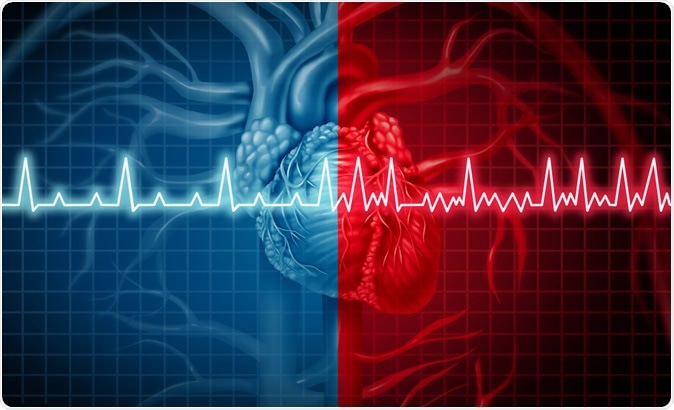If there could be one organ in the body that works 24/7 nonstop and makes sure the cells get the oxygen and nutrients they need, it’s the heart. The heart also needs its supply of blood rich in oxygen, and in the event, it doesn’t receive adequate amounts of blood, it can suffer serious complications. Atrial fibrillation, for one, is an irregular heartbeat that affects blood flow to the heart muscle and the rest of the body.

Illustration Credit: Lightspring / Shutterstock
A new study by researchers at Baylor College of Medicine unveils the molecular changes that underlie the devastating rhythm disorder. Atrial fibrillation causes palpitations in the chest and could halt the heart from pumping blood efficiently.
Atrial fibrillation (AF) is the most common arrhythmia across the globe. In 2010, the estimated number of people with the heart condition was 33.5 million, but this doesn’t include those who are asymptomatic who remain undiagnosed.
AF is now considered a global health problem, since it contributes to the occurrence of serious complications that may lead to morbidity and mortality, including congestive heart failure, embolic stroke, and acute coronary syndrome.
What happens during atrial fibrillation?
Normally, the heart contracts and relaxes to a regular beat. However, in patients with atrial fibrillation, the upper chambers or atria of the heartbeat irregularly like a quiver, rather than pumping blood effectively into the ventricles.
In the study published in Circulation, the American Health Association (AHA) Journal, the researchers want to determine the underlying mechanism of the pathogenesis of atrial fibrillation.
It is known that abnormal calcium release from the sarcoplasmic reticulum contributes to the development of AD. But, until now, the two processes, SR calcium release and reuptake, were thought to be mediated by separate systems. The study, however, points out changes in the current model.
“At the molecular level, calcium is essential for maintaining a healthy heartbeat," Dr. Xander Wehrens, professor of molecular physiology and biophysics, said in a statement.
"Proper contraction and relaxation of the heart depend on the coordinated flux of calcium ions in and out of individual cardiac muscle cells,” he added.
New molecular players that lead to atrial fibrillation
In the past, it is known that SR calcium release and reuptake are separate functional entities. In the study, the researchers discovered two essential protein machines, a calcium release channel, and a calcium reuptake pump, which are all regulated by the same molecular mechanism in heart cells.
To land to their findings, the team studied the molecular players in the regulation of SR calcium cycling. Using complexome profiling, the team discovered that a phosphate regulatory subunit, called PPP1R3A. This connects to both the SR calcium release and reuptake complexes. As a result, they form one unit, a super-complex, that is present in atrial cells.
To confirm their finding, they used STimulated Emission Depletion, a novel imaging procedure. They were able to see the two complexes are near each other.
The discovery could later provide new information for the development of new therapies and treatment choices for atrial fibrillation. They were able to visualize individual molecules and were able to measure the distance between them.
“We found that components of the calcium release complex overlap with components of the calcium reuptake complex and that this super-complex is also present in tissue samples from human atria,” Dr. Wehrens, explained.
PPP1R3A is a key player in susceptibility to atrial fibrillation
The researchers conclude that PPP1R3A could be one of the molecular controllers that helps maintain the integrity of the new super-complex. In fact, when the team tried to delete of the PPP1R3A in mice altered the formation of the super-complex, which led to an abnormal SR calcium cycling, increasing the vulnerability to having atrial fibrillation.
They also found that the PPP1R3A levels were reduced in patients with atrial fibrillation. The results of the study could provide new information on the development of new atrial fibrillation therapies and treatment.
Aside from that, since the decreased amount of PPP1R3A could lead to both atrial fibrillation and calcium handling, the new finding could lead to the development of a treatment that could treat both flaws at the same time.
"Our joint work, which originated through independent efforts and methodologies in different laboratories, also shows the importance of international collaboration to understand and eventually develop new therapies for complex diseases such as atrial fibrillation,” Dr. Stephan Lehnart at the University of Goettingen in Germany, said.
Journal reference:
Alsina, K., Hulsurkar, M., Brandenburg, S., Kownatzki-Danger, D., Lenz, C., Urlaub, H., Abu-Taha, I., Kamler, M., Chiang, D., Lahiri, S., Reynolds, J., Quick, A., Scott, L., Word, T., Gelves, M., Heck, A., Li, N., Dobrev, D., Lehnart, S., and Wehrens, X. (2019). Loss of Protein Phosphatase 1 Regulatory Subunit PPP1R3A Promotes Atrial Fibrillation. Circulation. https://www.ahajournals.org/doi/10.1161/CIRCULATIONAHA.119.039642